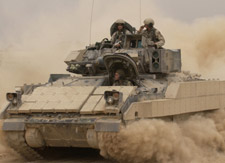Depleted Uranium
First deployed on a large scale during the Gulf War, the U.S. military uses depleted uranium (DU) for tank armor and some bullets due to its high density, helping it to penetrate enemy armored vehicles. DU is a byproduct of the Uranium (U) enrichment process where the ratio of natural U isotopes from the earth’s crust is ‘enriched’ with higher energy U isotopes to produce U suitable for use in nuclear reactors. The U remaining is "depleted" of about 40 percent of its radioactivity, but retains the same chemical toxicity as natural uranium. If you think you were exposed to depleted uranium during your service, talk to your local VA Environmental Health Coordinator. Ask to be screened for depleted uranium exposure.
How Veterans may have been exposed

Some Gulf War, Bosnia, Operation Enduring Freedom (OEF), Operation Iraqi Freedom (OIF), and Operation New Dawn (OND) Veterans may have been exposed to DU when they were: on, in, or near vehicles hit with friendly fire; entering or near burning vehicles; near fires involving DU munitions; or salvaging damaged vehicles.
When a projectile made with DU penetrates a vehicle, small particles of DU can be formed and breathed in or swallowed by service members in the struck vehicle. Small DU fragments can also scatter and become embedded in muscle and soft tissue.
Health problems associated with depleted uranium
DU is a potential health hazard if it enters the body, such as through embedded fragments, contaminated wounds, and inhalation or ingestion. This is because U’s radiation, while of high energy, penetrates poorly through tissues in the body. Simply riding in a vehicle with DU weapons or DU shielding will not expose a service member to significant amounts of DU or external radiation.
The potential for health effects from internal exposure is related to the amount of DU that enters a person’s body. Inhaled DU particles are likely cleared from the lungs over several years. DU fragments may remain for many years. Older studies in U manufacturing workers show high exposures to U may especially affect the kidneys.
To date, in a group of Veterans exposed to DU in friendly fire events, there has been no health impact to the kidney noted, however, recent research shows there may be an association between elevated urine uranium in these Veterans and lower bone mineral density (BMD). The BMD results require further study to determine if they persist over time and researchers and clinicians continue to monitor the health of these Veterans.
Health concerns?
If you are concerned about depleted uranium exposure during service, talk to your health care provider or local VA Environmental Health Coordinator. Ask to be screened for depleted uranium exposure. Veterans who served in the Gulf War, Bosnia, OEF, OIF, or OND may be eligible for the Depleted Uranium Follow-up Program at the Baltimore VA Medical Center, a program to screen and monitor health problems associated with depleted uranium exposure from friendly fire incidents.
VA offers a variety of health care benefits to eligible Veterans. Learn more about VA health care.
Compensation benefits for health problems
Veterans may file a claim for disability compensation for health problems they believe are related to exposure to depleted uranium during service. VA decides these claims on a case-by-case basis. File a claim online.
Learn more about VA benefits.




















